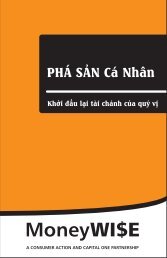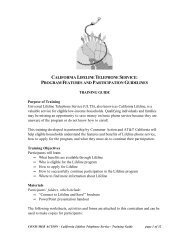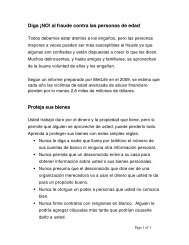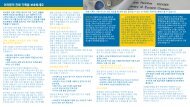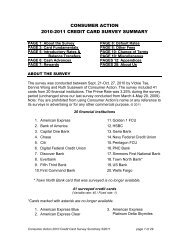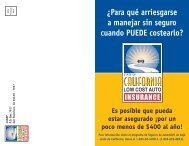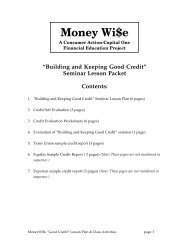Using Credit Wisely Seminar - Consumer Action
Using Credit Wisely Seminar - Consumer Action
Using Credit Wisely Seminar - Consumer Action
- No tags were found...
You also want an ePaper? Increase the reach of your titles
YUMPU automatically turns print PDFs into web optimized ePapers that Google loves.
<strong>Seminar</strong> Purpose:<strong>Using</strong> <strong>Credit</strong> <strong>Wisely</strong> <strong>Seminar</strong>To provide workshop participants with an understanding of the benefits, costs, and responsibilitiesof revolving credit and the information they will need to obtain credit and use it wisely.<strong>Seminar</strong> Objectives:By the end of the training, participants will understand:• The different types of credit available.• The advantages and disadvantages of credit.• The costs of credit.• How to compare terms and choose the best credit card.• How to read a credit card statement.• How to use credit wisely, and avoid penalty fees and rates.• Where they can obtain additional information and assistance<strong>Seminar</strong> Duration:This is a three-hour seminar. There will be one fifteen-minute break about halfway through.Materials:For instructor:• Staying on Track with <strong>Credit</strong> brochure• <strong>Credit</strong> training manual - Questions & Answers About Obtaining and Managing <strong>Credit</strong>• <strong>Using</strong> <strong>Credit</strong> <strong>Wisely</strong> visual teaching aid (PowerPoint presentation with instructor’s notes)• <strong>Using</strong> <strong>Credit</strong> <strong>Wisely</strong> seminar lesson plan:You will also need:o Lesson plan (pages 4-15)o Sample <strong>Credit</strong> Card Billing Statemento Sample <strong>Credit</strong> Card Solicitationo <strong>Credit</strong> Card Match-Up scenarioso Disclosure chart for credit card matching activityo Copy of most recent <strong>Consumer</strong> <strong>Action</strong> <strong>Credit</strong> Card Survey (optional; download PDFfrom www.consumer-action.org and make copies)o <strong>Credit</strong> Card Comparison Worksheet (for at-home use)o Evaluation form for the <strong>Using</strong> <strong>Credit</strong> <strong>Wisely</strong> seminar• A computer and an area on which to project the PowerPoint presentation• An easel and pad, or a whiteboard, and markers© 2009 <strong>Consumer</strong> <strong>Action</strong> Page 2 of 20
For participants:• Staying on Track with <strong>Credit</strong> brochure• Copy of seminar PowerPoint slides (optional)• Sample <strong>Credit</strong> Card Billing Statement• Sample <strong>Credit</strong> Card Solicitation• Copy of most recent <strong>Consumer</strong> <strong>Action</strong> <strong>Credit</strong> Card Survey (optional)• <strong>Credit</strong> Card Comparison Worksheet (for at-home use)• Evaluation form for the <strong>Using</strong> <strong>Credit</strong> <strong>Wisely</strong> seminar•<strong>Seminar</strong> OutlineSession One – TopicsMinutesWelcome (10)Advantages of <strong>Credit</strong> (15)Types of <strong>Credit</strong> (10)Card Types (10)<strong>Credit</strong> Card Terms (20)Group Activity: <strong>Credit</strong> Card Quiz Game (15)Reading a <strong>Credit</strong> Card Billing Statement (15)Break (15)Session Two – TopicsMinutesComparing <strong>Credit</strong> Cards (20)Group Activity: <strong>Credit</strong> Card Match-Up (15)Obtaining <strong>Credit</strong> (10)<strong>Using</strong> <strong>Credit</strong> <strong>Wisely</strong> (15)Questions & Answers (10)Wrap-up and Evaluation (5)© 2009 <strong>Consumer</strong> <strong>Action</strong> Page 3 of 20
Session OneInstructor’s Note: Before conducting the training, familiarize yourself with the Staying on Trackwith <strong>Credit</strong> brochure, the credit training manual (Q&A About Obtaining and Managing <strong>Credit</strong>), andthe PowerPoint presentation. The PowerPoint presentation contains notes for each slide. Thesenotes offer talking points, and detailed information about the items appearing on the slide. Thislesson plan indicates which slides correspond to which parts of the lesson, and when to move to thenext slide.➡SLIDE #1 (onscreen as participants arrive)Have participants pick up packets on their way in, or place them on seats/tables before class. Directparticipants who arrive early to begin reading the Staying on Track with <strong>Credit</strong> brochure.Welcome (10 minutes)Welcome participants. Introduce yourself and review the purpose of the seminar and the day’sagenda.You can hand out packets at this point if you have not already done so.Review the contents of participants' packets. Ask the class to take a look inside their packets andmake sure they have all the materials needed.Ask participants to introduce themselves and tell you what they hope to get out of the seminar. Onyour whiteboard or easel pad, jot down some of the topics participants want to learn about.(This activity is designed to serve as a brief icebreaker. It will also give you an idea of whatparticipants’ expectations and needs are.)Briefly go over the schedule for the day.Advantages of <strong>Credit</strong> (15 minutes)Introduction: <strong>Credit</strong> can be an important financial tool.Ask the class, “What are the advantages of having credit?”TIP: This can be done informally, with participants calling out answers. If you like, you can writedown their responses on the easel pad or whiteboard.After a moment or two of brainstorming, reveal the following slide.➡SLIDE #2Per slide notes, present each item in the list.© 2009 <strong>Consumer</strong> <strong>Action</strong> Page 4 of 20
Encourage discussion by asking:• When does it make sense to pay for a purchase over time? When is it not a wise choice?(It can make sense to purchase a big-ticket item, such as a washing machine, on credit if, forexample, the purchase could ultimately save you money and will last a much longer time thanthe repayment period, or if you were planning to make the purchase soon anyway but youhave the opportunity to get a great deal (save money) if you do it now. It doesn’t make senseto purchase things on credit that will not increase in value, will not save you money, will go outof style or lose usefulness before they are paid off, or are not necessities.• Have you ever found you couldn’t do something—like rent a car or buy an airline ticket—because you didn’t have a credit card? What did you do?• (After going through all items in list): What do you find are the biggest advantages of having acredit card? Are there any disadvantages?There are no right or wrong answers here. A couple of disadvantages to point out, if they arenot offered by participants, are the potential to accumulate too much debt, and the higher costof purchases—because of finance charges and fees—if you do not pay your bill in full eachmonth or if you do not abide by all terms of the credit agreement.Types of <strong>Credit</strong> (10 minutes)Introduction: There are two main types of credit: installment credit and revolving credit.Ask the class, “What are some examples of installment credit?”After a moment of brainstorming, ask the class, “What are some examples of revolving credit?” Afteranother moment or two, reveal the next slide.➡SLIDE #3Per slide notes, go over each item in the list.When presenting the point about how the available credit fluctuates as you make purchases andpayments, present the following example on the easel pad or whiteboard:EXAMPLE OF REVOLVING CREDIT: Let’s say you have a credit limit of $500… This month you make purchases totaling $200… That leaves you with available credit of $300 ($500 - $200)… When your bill comes, you make a payment of $150… How much credit will you have available to use now? $450 ($300 + $150)Note: This example assumes the cardholder did not carry over a balance from the previous month,so there are no finance charges on the current balance. Let the class know you’ll talk about creditcard finance charges soon.© 2009 <strong>Consumer</strong> <strong>Action</strong> Page 5 of 20
After covering all points on the slide, remind the class that today’s seminar will focus on short-termrevolving credit—credit cards, in particular.Card Types (10 minutes)Introduction: Did you know that nearly one in every three purchases in the U.S. is made with sometype of “plastic”—a credit, charge, debit or prepaid card?Different types of cards offer different features, costs and benefits. You have to understand how allthese card types differ before you can choose the best one—or ones—to meet your needs.➡SLIDE #4Per slide notes, go over each item in the list.Point out that many consumers have more than one type of card—for example, it’s common tocarry, say, a widely accepted credit card, a gas card (which is also a type of credit card), and a debitcard.<strong>Credit</strong> Card Terms (20 minutes)Introduction: Every credit card comes with guidelines, or rules, regarding use, cost and payment.These are called “terms.” If you want to choose the best card for your needs, and avoid penaltiesafter you have chosen a card, you must understand the card’s terms.Let’s go over some key credit card terms.➡SLIDE #5Per slide notes, go over each item in the list.➡SLIDE #6Per slide notes, go over each item on the slide.➡SLIDE #7Per slide notes, go over each item on the slide.Activity instructions:Group Activity: <strong>Credit</strong> Card Quiz Game (15 minutes)Break the class into three teams. Instruct each team to choose one person to “buzz” in when theythink their team has the right answer. (Buzzing in could mean raising a hand, making a buzzingnoise, ringing a bell you provide, etc.)Read each of the “answers,” one by one. (There are 14 answers and questions.)© 2009 <strong>Consumer</strong> <strong>Action</strong> Page 6 of 20
Q: Why was Sarah assessed a $25 late fee last month?A: Based on the payment due date for this month, we can assume her payment due date for theprevious month (June) was around the same time. According to this statement, however, her $75payment only posted on June 28 th .Q: Which transactions decreased Sarahʼs balance?A: Her payment of $75 and a return at BuyRight department store for $16.Q: What is the minimum amount Sarah must pay to avoid a late charge this month? Why is it sohigh—nearly 10% of the outstanding balance?A: $67 (Point out the Minimum Payment Due.) It is high because Sarah must pay the entire late feeand finance charge in addition to the 3% to 4% of her balance.Q: Is this a rewards card?A: Yes. (Point out the Points information, just above TRANSACTIONS.)Q: Why was Sarah assessed a finance charge this month?A: For two reasons: First, she carried over a balance from the previous month. (Point out PreviousBalance and Payments, <strong>Credit</strong>s.) Second, she took a cash advance—and there is a transaction feefor cash advances and no grace period, even if you do not revolve debt from the previous month.Q: Why does the number of days in the billing cycle matter?A: Because the number of days in the billing period will have a bearing on the average dailybalance, and that is what is used to calculate finance charges for the month.Q: If Sarahʼs interest rate is 21.99% for purchases and 27.99% for cash advances, why is theeffective APR 31.24%?A: It is because the effective APR includes transaction fees. This disclosure is designed to showyou the real cost of borrowing.Q: Why is it important to review your statement?A: To make sure payments and credits have been posted. To check for errors in charges and fees.To look for fraudulent charges, charges for merchandise you didn’t accept, or charges for an item orservice that was not delivered.If you find a mistake on your bill, contact the credit card company immediately (or at least within 60days of the first bill containing the error) to dispute the charges. You have the right to withholdpayment on the disputed amount while your card company is investigating, but you still have to payany part of the bill that’s not in dispute, including finance and other charges. Your dispute must beresolved within the shorter of two billing cycles or 90 days.© 2009 <strong>Consumer</strong> <strong>Action</strong> Page 9 of 20
Break (15 minutes)Announce a 20-minute break. Make yourself available for a few minutes to direct people to therestroom or a place to get drinks and snacks.Leave the following slide onscreen during the break.➡SLIDE #10Session TwoComparing <strong>Credit</strong> Cards (20 minutes)Introduction: Different credit cards cater to different needs. Before you apply for a credit card, youshould determine that it is a card that meets your needs, and that it is the best deal available to you.To find the right card, you have to know how you will use it. For example, if you are someone whoalways pays your balance in full each month, then the interest rate will be less important to you thancertain other terms, such as transaction fees or rewards. If you’re someone who travels a lot, thenthe currency conversion fee will be more important to you than it would be to someone who veryrarely travels outside the U.S.Once you have determined how you will use the card and which terms, features and benefits aremost important to you, you are ready to begin shopping for a credit card.➡SLIDE #11Per slide notes, go over each item.Upon reaching the last item in the list, ask the class, “Where do you find this information when youare considering a credit card?”Ask participants to remove the Sample <strong>Credit</strong> Card Solicitation from their packets.“By law, all credit cards must disclose certain information with every solicitation.” Go over each itemin the boxes, from Annual Percentage Rate (APR) for Purchases through the smaller box, below themain box, where balance transfer, late, and other fees are disclosed. Also, point out the paragraphbeneath that, which explains that payments will be applied to lower-rate balances before higher-ratebalances.(TIP: Prepare for this section by highlighting key information on your copy of the sample disclosure.)Then ask the following questions to get participants thinking about how to read and evaluate a creditcard disclosure.© 2009 <strong>Consumer</strong> <strong>Action</strong> Page 10 of 20
Q: For what reasons could the credit card company change your terms?A: “We may change them based on information in your credit report, market conditions, businessstrategies, or for any reason.” (First paragraph of solicitation.)Q: How long does the promotional (teaser) rate of 0% last on this card?A: 6 months (First line of Annual Percentage Rate (APR) for Purchases box and first line of OtherAPRs box.)Q: What could cause the promotional period to end sooner?A: “The Promotional Period will end sooner if your payment is late or the account balance is overthe credit limit.” (Second to last sentence in the same paragraphs that disclose the 0% promotionalrate for purchases and balance transfers.)Q: Based on this disclosure, if you took a $200 cash advance, how much would the cash advancefee be?A: $10. The regular cash advance fee is 3% of the transaction amount, which would be $6 on a$200 cash advance. However, this card imposes a minimum cash advance fee of $10. (This isdisclosed in the smaller box below the main disclosure box.)Q: How much higher is the cash advance APR than the regular purchase or balance transfer APR?A: 4%. The margin for the purchase/balance transfer APR is 8.99%. The margin for the cashadvance APR is 12.99%. (This is disclosed in the Variable-Rate Information box.)Q: If the prime rate increases to 7%, what will your interest rate on purchases be?A: 15.99% (7% + 8.99%).Q: How much is the penalty APR?A: 29.99%. (This is disclosed under Other APRs.)Q: If you took advantage of the 0% balance transfer offer and transferred $1,000 to this card, whatis the amount of the balance transfer fee you would have to pay?A: $0 (“Standard Balance Transfer Fee: None.” This is disclosed in the smaller box below the maindisclosure box.)Q: If you have a balance of $400 and you make your payment late, how much will your late fee be?A: $39. The late fees are based on the balance. In this case, balances of more than $250 carry a$39 fee. (This is disclosed in the smaller box below the main disclosure box.)Q: Does it matter what time your payment arrives on the due date?A: Yes. According to this disclosure, it must arrive by 5 p.m. Eastern time. (This is disclosed in item#2, below the boxes.)Q: If you do not agree with one of the terms of the agreement, can you cross it out before submittingthe application?A: You can accept or decline the agreement, but you cannot make changes to it. (“Any changes Imake to the terms of this application will have no effect.” This is disclosed under the AGREEMENT© 2009 <strong>Consumer</strong> <strong>Action</strong> Page 11 of 20
section.)Q: How would a credit card company notify you of any changes to these terms?”A: The credit card company can change any of the terms with 15 days’ written notice. Such noticesare often included with cardholders’ billing statement, so always check the material sent along withyour bill for important notices.Group Activity: <strong>Credit</strong> Card Match-Up (15 minutes)Introduction: Now that you know how to read a credit card disclosure and evaluate credit cardterms, you can help a few credit card shoppers who are having some trouble deciding which card toapply for.➡SLIDE #12Divide the class into groups. (Due to time constraints, it’s best to not exceed three or four groups.)Give each group a copy of the Help Our Shoppers Choose the Right <strong>Credit</strong> Card worksheet and asmany copies of the Disclosure Chart for <strong>Credit</strong> Card Match-Up as necessary to allow everyone inthe groups to view it and participate.Instruct the class to take 10 minutes to answer the five questions, basing their choices on theinformation in the consumer profiles and the knowledge they already have. As is the case in reallife, there is not necessarily one perfect card for each consumer.Direct each group to select a representative to explain why they made the choices they did. At theend of the work period, go over the questions one by one, asking each group to explain its choice(s)for that particular scenario.Here are some talking points to guide you through each question/scenario:1. The only card that will allow Javier to transfer his entire $4,000 balance is the WorldExpress Visa,since it offers a $5,000 credit limit. He will have to pay a $75 annual fee and 3% of the balancetransfer amount, or $120. He will get 0% interest for three months, and then his interest rate willjump to 22.99%. If Javier chooses <strong>Credit</strong>Max Visa, he will not be able to transfer the entire amount,so he’ll have to leave $1,000 on his old card—that may be a deal breaker for him. On the up side,the annual fee on this card is only $50, and there is no balance transfer fee (a savings of $120).And, the promotional interest rate of 0% lasts 9 months—6 months longer than the WorldExpressVisa. That is enough time to pay down a significant portion of the balance at 0%, resulting insavings that could be as high as $300 or more ($4,000 x 18.99% = $760/year; $760/12 =$63/month; $63 x 6 months = $378 ; actual savings depends on the monthly payment and resultingbalance during each of those six months paying interest on the WorldExpress Visa). However,Javier will pay a higher interest rate (21.99%) on the <strong>Credit</strong>Max Visa after those first 9 months thanhe would on the WorldExpress Visa.2. Neither the EZSpend MasterCard nor the Quik<strong>Credit</strong> MasterCard offer rewards, so Rita will wantto choose between the two Visa cards. Since she pays off her balance every month, she isprobably not too concerned that the <strong>Credit</strong>Max Visa charges a higher interest rate of 25.99%. Andsince she makes significant charges but does not travel much, she will probably benefit much morefrom the 1% cash back that the <strong>Credit</strong>Max Visa offers than she would from the airline miles offeredby WorldExpress Visa.© 2009 <strong>Consumer</strong> <strong>Action</strong> Page 12 of 20
3. Since Jackson uses his card mainly to pay for large expenses that he has to finance over anumber of months, he will want to pay close attention to the interest rate for purchases. WhileWorldExpress Visa and <strong>Credit</strong>Max Visa offer 0% promotional rates, he may not even use the card inthose first months. And once those rates expire, Jackson will be faced with rates of 22.99% and25.99%. The EZSpend MasterCard offers the best long-term purchase rate, at 15.99%. Also, thereis no annual fee. And the credit limit of $1,500 is likely to be high enough to accommodate theoccasional car repair, airline ticket or big-ticket purchase. The method of computing the balancealso is in his favor, since it excludes new purchases.4. Lynette’s best options are probably the WorldExpress Visa and the EZSpend MasterCard. Thebig advantage of the Visa is that it is a rewards card that awards airline miles—something Rita couldreally use. The advantages of the MasterCard are that it charges a lower interest rate (15.99%compared to 18.99%) and a lower currency conversion fee (1% compared to 3% of the transactionamount), with no minimum (compared to the Visa’s $10 minimum). This is significant, since shemakes many of her transactions overseas. Also, the MasterCard has no annual fee. Regarding herlate payments, Lynette would not be penalized quite as much with the MasterCard, since it chargesa lower late fee and a slightly lower default rate. However, these penalties are still significant,especially when you compare the MasterCard default APR of 26.99% to the regular purchase APRof 15.99%. On a $2,000 balance, that is the difference between paying $540 and paying $320 inannual interest. One way for Lynette to avoid late payments, even when she is traveling, is to set upautomatic payments with her credit card issuer.5. Leslie and Lee can limit their risk somewhat by choosing the Quik<strong>Credit</strong> MasterCard, which has acredit limit of $300. And, there is no annual fee. What Leslie and Lee should be aware of, however,is that their liability is not limited to $300. If their son defaults, it could be only after accruing manymonths of finance charges and miscellaneous fees.Obtaining <strong>Credit</strong> (10 minutes)Introduction: If you don’t already have a credit card, you may wonder how and where to get one.There are a number of ways to get a credit card. How you do it depends on your credit history andyour credit needs.➡SLIDE #13Per slide notes, go over each item.<strong>Using</strong> <strong>Credit</strong> <strong>Wisely</strong> (15 minutes)Introduction: Once you have a credit, you have to use it wisely, because good credit is a valuabletool. Ask the class, “What is “good credit?”After a moment or two of input, ask the class, “Why is it important to have good credit?”After a moment or two of input, explain that, “among other benefits, a good credit history enablesyou to qualify for lower interest rates on credit in the future. Take a look at how their credit historyaffects the two car loan applicants in this example.”As you present the example, write key info/numbers on your easel or whiteboard:© 2009 <strong>Consumer</strong> <strong>Action</strong> Page 13 of 20
Jose and his friend Gordon both apply for a 36-month (three-year) car loan of $18,000:Borrower: Jose Gordon<strong>Credit</strong> Score: 695 600Interest Rate: 8.138% 15.277%*Monthly Payment: $785 $870Total Paid: $28,260 $31,320Cost of a low credit score: $3,060 over three years…more than $1,000 per year!Note that Gordon must pay an interest rate nearly double what Jose has to pay. And his monthlypayment is $85 higher.*Scores and corresponding interest rates provided by myFICO.com.In addition to saving you money on interest, as it did for Jose, good credit can have a bearing onyour ability to rent a home, get a job, buy insurance, or receive utility, cell phone and other servicessince employers, insurance companies, landlords and service providers often look at your creditreport or credit score to see how reliable you have been in repaying your debts.”Ask the class, “How can you achieve good credit?” After a few moments of brainstorming, continue.“Good credit is a result of using credit wisely. What does that mean?”Reveal the next slide.➡SLIDE #14Per slide notes, go over each item.When presenting the point about paying more than the minimum, ask the class, “How long do youthink it would take you to pay off a $2,000 credit card balance at 19.99% interest if you paid only theminimum monthly amount?”After getting a few guesses, continue.Answer: 10 years. This assumes a monthly payment of 4% of the balance, or $10, whichever isgreater. And it does not take into account any late, overlimit or other fees.Ask the class, “How much do you think you’d pay in interest on that $2,000 debt over those 10years?”Answer: About $1,325.© 2009 <strong>Consumer</strong> <strong>Action</strong> Page 14 of 20
Questions & Answers (10 minutes)Preparation: Review <strong>Using</strong> <strong>Credit</strong> <strong>Wisely</strong> training manual and brochure.Open the floor to questions. The training manual is written in Q&A format to help you answerfrequently asked questions.After answering questions, point out the following in participants’ folders:• <strong>Credit</strong> Card Comparison Worksheet: Encourage participants to use this worksheet when theyshop for a new credit card, or to compare the terms and features on cards they already have. (Theymay find they have a card now that is not very consumer friendly.)➡SLIDE #15Wrap-up and Evaluation (5 minutes)Congratulate attendees on their participation in the seminar and wish them success. Ask them to fillout the seminar evaluation form and leave it on a table or in a large envelope you provide.© 2009 <strong>Consumer</strong> <strong>Action</strong> Page 15 of 20
SAMPLE CREDIT CARD BILLING STATEMENTStatement for account #: 1234 5678 9012 3456Sarah Sanborn123 Lucky LaneMapletown, NY 12345Quik<strong>Credit</strong> MasterCardPO Box 123Plasticville, DE 64532Opening/Closing Date: 6/6/08 – 7/5/08Past Due Amount:New Balance:Payment Due Date: 7/25/08Minimum Payment Due: $67.00ACCOUNT SUMMARYPrevious Balance: $332.56 Total <strong>Credit</strong> Line: $1,000.00Payments, <strong>Credit</strong>s: $91.00 Available <strong>Credit</strong>: $243.54Purchases, Cash, Transfers,Number of DaysFees, Finance Charges: $ 514.90 in Billing Cycle: 30Previous Points Balance: 2,456Points Earned This Period: 373Points Redeemed This Period: 0Points Balance: 2,829TRANSACTIONSDate Merchant Name or Transaction Description <strong>Credit</strong> Debit6/10 Balance Transfer 300.006/14 FlowerWorld 50.006/20 BuyRight Department Store 16.006/26 Late Fee 25.006/28 Payment 75.007/2 Happy Burger 23.427/3 Cash Advance 100.007/3 Cash Advance Fee 5.007/5 Finance Charge 11.48FINANCE CHARGESPurchase APR: 21.99% Cash Advance APR: 27.99%Average Daily Balance: 620.00 Average Daily Balance: 10.00Transaction Fee: 0.00 Transaction Fee: 5.00Finance Charges: 10.48 Finance Charges: 1.00Effective APR: 31.24% (Represents your total finance charges, including transaction fees—expressed as a percentage.)© 2009 <strong>Consumer</strong> <strong>Action</strong> Page 16 of 20
SAMPLE CREDIT CARD SOLICITATIONAll account terms are governed by the <strong>Credit</strong> Card Agreement. Account and Agreement terms arenot guaranteed for any period of time; all terms, including the APRs and fees, may change inaccordance with the Agreement and applicable law. We may change them based on information inyour credit report, market conditions, business strategies, or for any reason.† Annual PercentageRate (APR) forPurchasesOther APRs0% Introductory APR for the first 6 statement Closing Dates following theopening of your account. After that, the Standard Variable APR is16.99% The Promotional Period will end sooner if your payment is late orthe account balance is over the credit limit. See 1 and 3 below.Balance Transfers: 0% Introductory APR for the first 6 statement ClosingDates following the opening of your account for all Balance Transfers,Check Cash Advances, and Direct Deposits. After that, the APR for anybalances that were subject to the Introductory APR is 16.99%. TheStandard Variable APR for Balance Transfers is 16.99%. The IntroductoryAPR will end sooner if your payment is late or the account balance is overthe credit limit. See 1 and 6 below.Cash Advances: Standard Variable APR is 20.99% for all Direct Deposits,Check Cash Advances, ATM Cash Advances, Bank Cash Advances,Overdraft Protection and Cash Equivalent transactions. See 7 below.Default APR: Up to 29.99% for all Purchase, Balance Transfer, and CashAdvance balances if late or overlimit. This is not a variable rate. See 2.Variable-RateInformationGrace Period forrepayment ofbalance forPurchasesMethod of computingbalance forPurchasesAnnual FeeMinimum FinanceChargeForeign TransactionsYour APRs may vary. For each billing cycle, we determine each APR byadding a margin to the prevailing U.S. Prime Rate. The margin for theStandard APR for Purchases and Balance Transfers is 8.99%. The marginfor the Standard APR for Cash Advances is 12.99%. See 3 below.At least 20 days from the statement Closing Date (provided you fully paidyour New Balance Total from the previous statement by its Payment DueDate). See 4 below.Average Daily Balance(including new purchases).None.$0.50Transaction fee for any transaction made in a foreign currency: 3% of theU.S. Dollar amount of each transaction. Fee will be in addition to otherapplicable fees.© 2009 <strong>Consumer</strong> <strong>Action</strong> Page 17 of 20
Standard Balance Transfer Fee: None.Standard Cash Advance Fee: 3% of each such transaction (minimum $10).Late Fee: Based on your balance as of the day the fee is assessed - $15 if $0 - $100; $29 ifbetween $100.01 - $250; $39 if $250.01 or over.Overlimit Fee: Based on your balance as of the day the fee is assessed - $15 if $0 - $500; $29 ifbetween $500.01 - $1000; $39 if $1000.01 or over.If your account has balances with different APRs, payments are applied to the balance with thelowest APR before any payments are applied to balances with higher APRs. This means thatbalances with higher APRs are not reduced until balances with lower APRs have been paid off.1 The Introductory APR(s) is effective upon the opening of your account and does not apply to CashAdvances, other than Check Cash Advances and Direct Deposits. When the Introductory APR(s)ends, the Standard (non-introductory) Variable APR is calculated using the Variable-RateInformation and is applied to new and outstanding balances (consisting of Purchases and BalanceTransfers). If your payment is late or the account balance is over the credit limit, the StandardVariable APR will be applied to those balances as of the first day of the billing cycle in which thepayment was late or the balance exceeded the credit limit. We reserve the right to change the APRsin our discretion including, for example, the margins.2 When your minimum payment is either late (i.e., not received by 5 p.m., ET, on its Payment DueDate), or the account balance is over the credit limit, on any two occasions within 12 consecutivemonths, we may increase each of your account Standard Variable APRs up to the Default APR. TheDefault APR will be applied to all new and outstanding balances with Variable APRs then below theDefault APR. If a Default APR is applied to your account, then all APRs, including APRs then at orabove the Default APR, will no longer vary.3 The U.S. Prime Rate used to determine your APRs for each billing cycle is the highest rateappearing in The Wall Street Journal on the last publication date of the calendar month that endswithin that billing cycle. On October 31, 2008, the U.S. Prime Rate was 4.0%.4 The number of days between your statement Closing Date and your Payment Due Date (thegrace period) may vary from one billing cycle to another.5 We include Transaction Fees when computing finance charges. Incurring Fees results in an APRexceeding 0% for the billing statement on which those fees appear. The Daily Periodic Rate (DPR)will remain 0% as disclosed.6 Check Cash Advances and Direct Deposits that post to your account after this promotional offerends will be Cash Advances with a 20.99% Standard Variable APR.7 Cash Equivalent transactions are defined as money orders, foreign currency, and travelers checksfrom a non-financial institution, person to person money transfers, bets, lottery tickets, casinogaming chips and bail bonds.AGREEMENTBy submitting this application, I agree to the conditions described below and to be bound by each ofthe terms of the <strong>Credit</strong> Card Agreement, including arbitration:© 2009 <strong>Consumer</strong> <strong>Action</strong> Page 18 of 20
I have read this application, and everything I have stated is true. I am at least 18 years of age or Iam at least 21 years of age if a permanent resident of Puerto Rico. I authorize XYZ Card Services,N.A. (hereinafter "you" or "your") to review my credit and employment histories and any otherinformation in order to approve or decline this application, service my account, and manage yourrelationship with me. I consent to your sharing of information about me and my account with theorganization, if any, endorsing this credit card program. I authorize you to share with others, to theextent permitted by law, such information and your credit experience with me. In addition, I may asa customer later indicate a preference to exempt my account from some of the information-sharingwith other companies ("opt-out"). If I accept or use an account, I do so subject to the terms of thisapplication, the "Details of Rate, Fee, and Other Cost Information," and the <strong>Credit</strong> Card Agreement(which includes an arbitration provision) as it may be amended; I also agree to pay all chargesincurred under such terms. Any changes I make to the terms of this application will have no effect. Iaccept that on a periodic basis my account may be considered for automatic upgrade at yourdiscretion. I consent to and authorize you, any of your affiliates, or your marketing associates tomonitor and/or record any of my phone conversations with any of your representatives.*BALANCE TRANSFERS. If the total amount you request exceeds your credit line, we may eithersend full or partial payment to your creditors in the order you provide them to us or we may sendyou Access Checks. Allow at least 2 weeks from account opening for processing. Continue payingeach creditor until the transfer appears as a credit. Balance Transfers incur finance charges fromthe transaction date. If you have a dispute with a creditor and pay that balance by transferring it toyour new account, you may lose certain dispute rights. Balance Transfers may not be used to payoff or pay down any account issued by XYZ Card Services, N.A.© 2009 <strong>Consumer</strong> <strong>Action</strong> Page 19 of 20
<strong>Credit</strong> Card Match-Up:Help Our Shoppers Choose the Right <strong>Credit</strong> Card1, Javier is looking for a new credit card that will allow him to transfer the $4,000 balance from hiscurrent credit card. He plans to pay off that balance over two years. Which card do you think Javiershould choose, and why?_____________________________________________________________________________________________________________________________________________________________________________________________________________________________________________2. Rita uses her credit card nearly every day—for groceries, gas, and just about all her otherpurchases—so that she can maximize her rewards. She pays off her balance every month. Shedoesn’t travel much. Which card do you think Rita should choose, and why?_____________________________________________________________________________________________________________________________________________________________________________________________________________________________________________3. Jackson uses a credit card only when he has an emergency expense or a big-ticket purchasethat he needs to finance over a number of months. Which card should Jackson choose, and why?_____________________________________________________________________________________________________________________________________________________________________________________________________________________________________________4. Lynette travels overseas frequently for work and for personal reasons. She usually revolves asmall balance from month to month. Because she is away from home so often, she sometimesmakes her credit card payment late. Which card do you think Lynette should choose, and why?What advice would you give her about her late payments?_____________________________________________________________________________________________________________________________________________________________________________________________________________________________________________5. Leslie and Lee would like to help their son establish credit, so they have agreed to be cosignersfor him. They realize that, as cosigners, they are responsible for repaying the debt if their sondefaults. Which card do you think Leslie and Lee should choose for their son, and why?_____________________________________________________________________________________________________________________________________________________________________________________________________________________________________________© 2009 <strong>Consumer</strong> <strong>Action</strong> Page 20 of 20


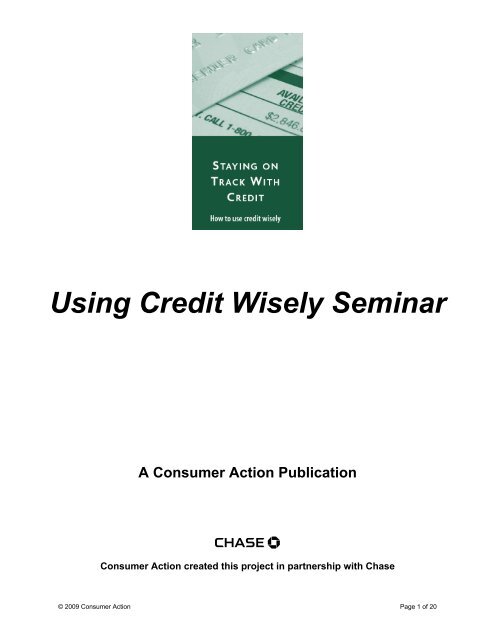
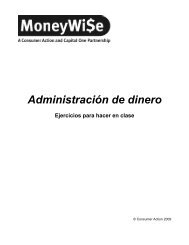
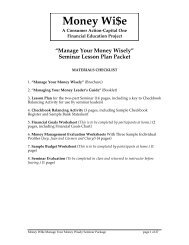
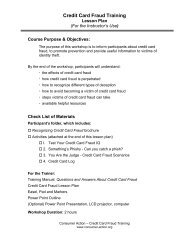


![Debt Collection Issue [Winter 2007-2008] - Consumer Action](https://img.yumpu.com/43405069/1/169x260/debt-collection-issue-winter-2007-2008-consumer-action.jpg?quality=85)
